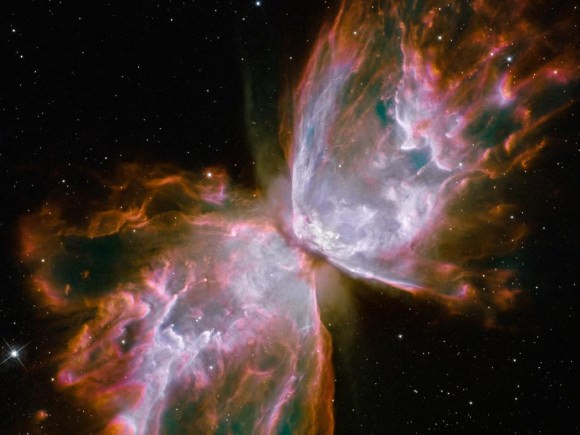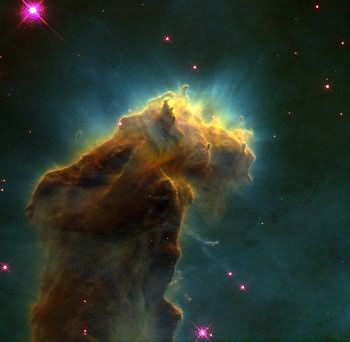NASA Science News for September 15, 2009
NASA is set to launch a sensitive new infrared telescope to seek out sneaky
things in the night sky -- among them, dark asteroids that could pose a threat to Earth.
FULL STORY at
http://science.nasa.gov/headlines/y2009/15sep_ninjaastronomy.htm?list1035898
Titan's Haze Acts as Ozone Layer
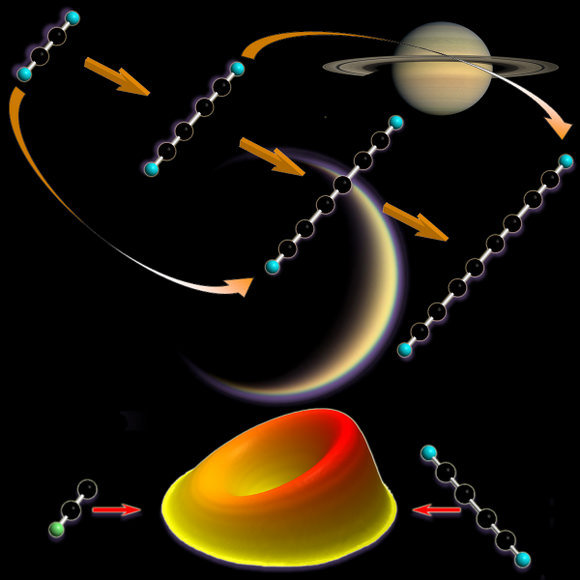
Titan appears to be more like Earth all the time, and a new understanding of Titan's hazy atmosphere could provide clues to the evolution of Earth's early atmospheric environment and the development of life on our home planet. Researchers have discovered a series of chemical reactions on Saturn’s largest moon that may shield the moon’s surface from ultraviolet radiation, similar to how Earth’s ozone layer works. The reactions may also be responsible for forming the large organic molecules that compose the moon’s thick and hazy orange atmosphere.
(...)
Read the rest of Titan's Haze Acts as Ozone Layer (377 words)
Mini Comets Ejected from Comet Holmes Caused Outburst
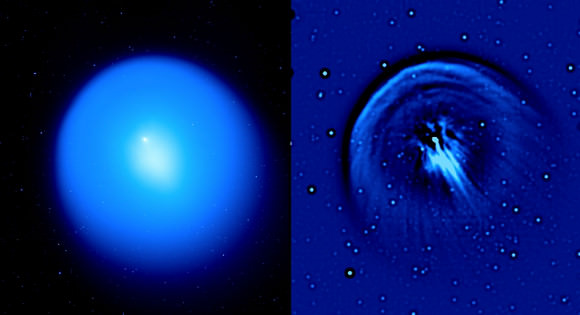
Comet 17P/Holmes caused a sensation in October and November 2007 when overnight, it brightened enough to be visible with the naked eye and became the largest cometary outburst ever witnessed. Using a special filter on the Canada- France- Hawaii Telescope in Hawaii, astronomers were able to peer inside Comet Holmes to determine why the comet became so bright. Images and animations show multiple fragments were ejected and rapidly flew away from the nucleus of comet Holmes.
(...)
Read the rest of Mini Comets Ejected from Comet Holmes Caused Outburst (446 words)
New Wallpaper for Star Trek, Cassini Fans
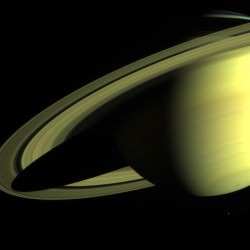
Star Trek fan? Like Cassini and Saturn? The very busy planetary scientist Carolyn Porco also has a visual graphics company, Diamond Sky Productions and they have created some new wallpapers featuring scenes from the latest Star Trek motion picture. The images are copyrighted, so we can't post them here, but no doubt you'll want to take a look at these spectacular images over at Diamond Sky's website. Enjoy!
Super Cell Lightning Storm Raging on Saturn Since January
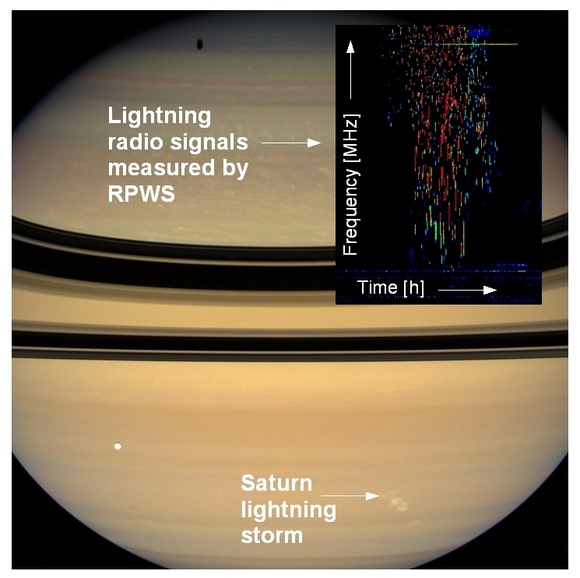
The Cassini spacecraft has been in orbit around Saturn since 2004 and during its mission, has watched nine different lightning storms rage on the planet. But this latest one is the longest lasting and most powerful storm yet: it has been going on since mid-January 2009 with no end in sight. It broke the storm duration record of 7.5 months set by another thunderstorm observed by Cassin between November 2007 and July 2008. Lightning discharges in Saturn's atmosphere emit very powerful radio waves which are about 10,000 times stronger than their terrestrial counterparts and the huge thunderstorms in Saturn's atmosphere have diameters of about 3,000 km.
(...)
Read the rest of Super Cell Lightning Storm Raging on Saturn Since January (353 words)
Interactive 360-Degree Panorama of Entire Night Sky Now Availabl
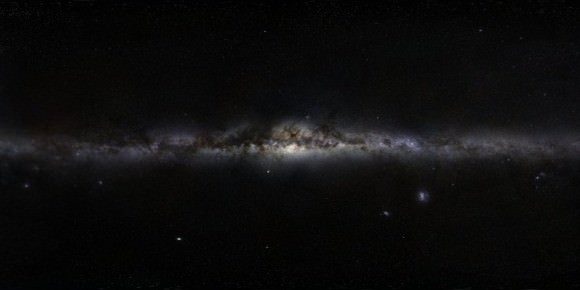
A stunning new 800-million-pixel panorama of the entire sky has been released online for everyone to enjoy. GigaGalaxy Zoom is a project for the International Year of Astronomy, and it allows users to dive right into the Milky Way Galaxy, and learn more about our celestial neighborhood. The project allows stargazers to explore and experience the Universe as it is seen with the unaided eye from ESO’s observing sites in Chile, one of the darkest and best viewing locations in the world.
(...)
Read the rest of Interactive 360-Degree Panorama of Entire Night Sky Now Available (245 words)
Temporary Radiation Belt Discovered at Saturn
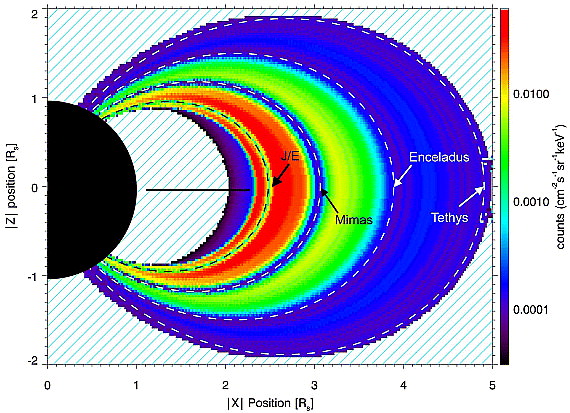
A new, temporary radiation belt has been detected at Saturn, located about 377,000 km from the center of the planet, near the orbit of the moon Dione. The temporary radiation belt was short-lived and formed three times in 2005. It was observed as sudden increases in the intensity of high energy charged particles in the inner part of Saturn's magnetosphere, in the vicinity of the moons Dione and Tethys, and likely was caused by a change in the intensities of cosmic rays at Saturn.
(...)
Read the rest of Temporary Radiation Belt Discovered at Saturn (435 words)
Jupiter Captured Comet as Temporary Moon
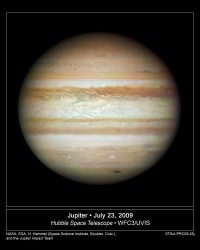
Jupiter's gravity well has been known to capture objects – evidenced by the recent impact on the gas giant discovered by amateur astronomer Anthony Wesley. But one object captured by Jupiter in the mid 1900's was later able to escape from the planet's clutches. Researchers have found comet 147P/Kushida-Muramatsu was captured as a temporary moon of Jupiter, and remained trapped in an irregular orbit for about twelve years. "Our results demonstrate some of the routes taken by cometary bodies through interplanetary space that can allow them either to enter or to escape situations where they are in orbit around the planet Jupiter,” said team member Dr. David Archer.
(...)
Read the rest of Jupiter Captured Comet as Temporary Moon (437 words)
LCROSS Impact Site on Moon Announced: Cabeus A
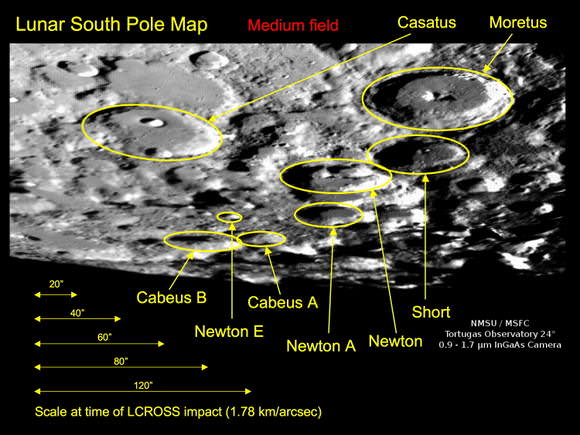
On October 9, 2009, at 7:30 a.m. EDT professional and amateur astronomers alike will be focusing their telescopes on the south pole of the Moon, hoping to see a little fireworks. Or more accurately, they are hoping to see ice. NASA will be sending the upper stage of a Centaur rocket to impact a permanently shadowed crater, along with the Lunar Crater Observation and Sensing Satellite, or LCROSS which will fly into the plume of dust left by the impact and measure the properties of the dust to look for water ice hidden inside the crater. LCROSS will collide with the lunar surface. Team scientists have been debating what crater would be the optimal location for the impact, and today they made their announcement: Cabeus A.
And just to clarify, the spacecraft will impact the Moon, NOT bomb it. No detonations involved.
(...)
Read the rest of LCROSS Impact Site on Moon Announced: Cabeus A (431 words)
NASA Science News for September 11, 2009
In search of water, NASA's Lunar Crater Observation and Sensing Satellite (LCROSS) is on a collision course with the Moon. Today NASA announced exactly where the impact will take place.
FULL STORY at
http://science.nasa.gov/headlines/y2009/11sep_lcrosstarget.htm?list1035898
Where In The Universe #70

Ready for another Where In The Universe Challenge? Here's #70! Take a look and see if you can name where in the Universe this image is from. Give yourself extra points if you can name the spacecraft responsible for the image. As usual, we’ll provide the image today, but won’t reveal the answer until tomorrow. This gives you a chance to mull over the image and provide your answer/guess in the comment section. Please, no links or extensive explanations of what you think this is — give everyone the chance to guess.
(...)
Read the rest of Where In The Universe #70 (0 words)
Hubble Wows With New Images
Hubble is back! The wait is over and here are the new pictures from the newly refurbished Hubble Space Telescope. Above is an image taken by the Wide Field Camera 3 (WFC3), a new camera aboard NASA’s Hubble Space Telescope, installed by NASA astronauts in May 2009, during the servicing mission to upgrade and repair the 19-year-old Hubble telescope. This is a planetary nebula, catalogued as NGC 6302, but more popularly called the Bug Nebula or the Butterfly Nebula.
NGC 6302 lies within our Milky Way galaxy, roughly 3,800 light-years away in the constellation Scorpius. The glowing gas is the star’s outer layers, expelled over about 2,200 years. The "butterfly" stretches for more than two light-years, which is about half the distance from the Sun to the nearest star, Alpha Centauri.
And there's more!
(...)
Read the rest of Hubble Wows With New Images (784 words)
Create Your Own Galaxy Mashup With New Galaxy Zoo Tool
If you haven't yet succumbed to the temptation of Galaxy Zoo, a new add-on to the popular citizen scientist project just might catapult you into joining the thousands of people who are clicking and classifying. Galaxy Zoo has now teamed up with Microsoft's World Wide Telescope to allow users to immerse themselves in the universe and be able to easily create videos and sky tours that can be customized and shared with friends and family. "Now there is an easy way to inflict your favorites on others," said Galaxy Zoo team member Dr. Pamela Gay.
(...)
Read the rest of Create Your Own Galaxy Mashup With New Galaxy Zoo Tool (654 words)
Magnetic Fields Have Key Influence on Star Formation
When a giant cloud of interstellar gas and dust collapses to form a new cluster of stars, only a small fraction of the cloud's mass ends up in stars. Scientists have never been sure why. But a new study provides insights into the role magnetic fields might play in star formation, and suggests more than the influence of gravity should be taken into account in computer models of stellar birth.
(...)
Read the rest of Magnetic Fields Have Key Influence on Star Formation (312 words)
NASA Science News for September 9, 2009
Today, astronomers declared the Hubble Space telescope a fully rejuvenated observatory with the release of spectacular new images and data from four of its six operating science instruments.
FULL STORY AND IMAGES at
http://science.nasa.gov/headlines/y2009/09sep_hubbleimages.htm?list1035898
